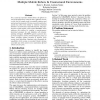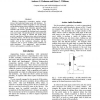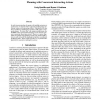797 search results - page 73 / 160 » On the Effects of Cooperation in DTNs |
ICRA
1998
IEEE
14 years 3 days ago
1998
IEEE
For a system of cooperative mobile robots to be effective in real-world applications, it must be able to efficiently execute a wide class of complex tasks in potentially unknown a...
ICIA
2007
13 years 10 months ago
2007
Effective human-robot cooperation requires robotic devices that understand human goals and intentions. We frame the problem of intent recognition as one of tracking and predicting...
HCI
2001
13 years 9 months ago
2001
This study investigates the effect of force-feedback in computer-mediated communication. Participants completed a screen-based maze task with an alleged remote participant in a 2 ...
WEBNET
2001
13 years 9 months ago
2001
: Teleworking enables a more flexible scheduling of working time and places of work on the way to the modern information society. The rapid development of cooperative application s...
AAAI
1997
13 years 9 months ago
1997
In order to generate plans for agents with multiple actuators or agent teams, we must be able to represent and plan using concurrent actions with interacting effects. Historically...




